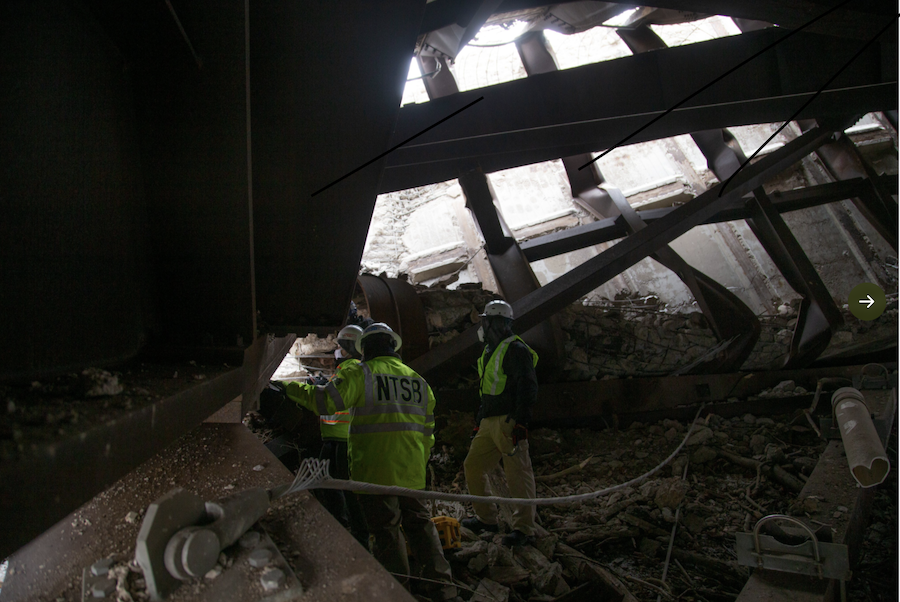(Story updated on 2/2/2022 with new information.)
The Pennsylvania Dept. of Transportation is seeking federal funding to cover the estimated $25.3-million cost for the planned rebuild of Pittsburgh's Fern Hollow Bridge, which suddenly collapsed on Jan. 28. PennDOT also anticipates using an accelerated procurement that would let it use a sole-source, design/build procurement method, a department official says.
PennDOT spokesperson Alexis Campbell says the department has notified the Federal Highway Administration that it intends to request federal Emergency Relief (ER) program funds "to assist with the cost of damages."
Campbell told ENR in a Feb. 2 email that PennDOT will be working with FHWA to determine what costs would be eligible for the Emergency Relief funding.
She added that any costs that are eligible for ER funds would reduce the need to draw on other types of federal highway aid, thus allowing PennDOT to use non-ER funds "for other needed infrastructure investments."
An FHWA spokesperson confirmed via email on Feb. 1 that the agency had received "a letter of intent/request" regarding emergency relief funds from Pennsylvania, which FHWA is reviewing.
Regarding the type of contract PennDOT would use for the rebuild, Campbell says the department "anticipates" using an accelerated procurement that follows FHWA "approved procedure."
She says, "This allows the Department to utilize a sole-source design/build contract" and therefore it will not issue an advertisement for bidders or teams.
Campbell adds, "Due to the sensitivity of the project and the requirement to perform work immediately, this is the most prudent way to procure the contractor and consultant team."
PennDOT did not specify when it would bring a design-team on board.
The cost figure of up to $25.3 million is based on PennDOT’s “rough estimate of all project phases" for the project, Campbell said in a Feb. 1 email.
She says that PennDOT "is thankful to be in a position to provide financial and engineering support for this emergency."
FHWA's Emergency Relief Program
In cases of hurricanes and other natural disasters, FHWA often releases Emergency Relief funds, which it has called a "down payment" for the costs of such things as post-disaster road and bridge repairs and debris removal.
In 2007, the agency also provided ER funds to Minnesota for expenses related to the 2007 collapse of the Interstate-35W bridge in Minneapolis, in which 13 people died and 145 were injured.
According to FHWA, the federal share of eligible Emergency Relief expenses may be 100% for emergency repairs "to restore essential travel, minimize the extent of damage or protect the remaining facilities" if the repairs are done within 180 days of the disaster.
The agency says the 180-day date for 100% federal funding "may be extended if a state cannot access a site to evaluate damages and the cost of repair."
In another action, PennDOT is inspecting each of the five other bridges in the state whose structure is the same as or similar to Fern Hollow’s. Campbell describes it as a steel "K-framed" structure. The bridge is owned by the City of Pittsburgh.
Campbell says, “Based on initial evaluation, all of the other bridges are in fair or better condition and are currently able to carry legal loads”—that is, they do not require posting weight restrictions. She says, “PennDOT will be conducting field valuations of these structures as well.”
NTSB's Probe Underway
A team from the National Transportation Safety Board has been on site carrying out the first stages of its investigation of the collapse.
NTSB Chair Jennifer Homendy has said that the board plans to release an initial report by about mid-February, dealing with factual information about the collapse, but not the cause. That could take 12 to 18 months, she said.
[View 1/29/2022 ENR story on NTSB's investigation here and ENR's initial story, dated 1/28/2022, on the bridge collapse here.]
Story updated on 2/2/2022 with new and clarified information from the Pennsylvania Dept. of Transportation





